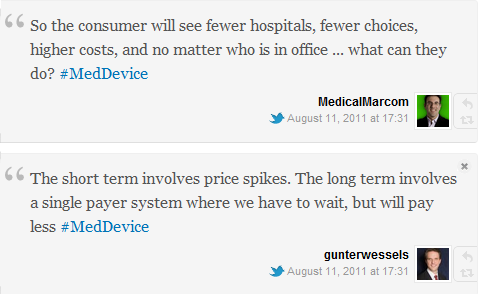 5 min reading time
5 min reading timeExpect a single payer system in the United States in ten years or so, says Gunter Wessels, national healthcare reform expert and healthcare practice principal for TIGI, specialists in healthcare sales training, business development, and sales force buy-in.
Joe Hage: Tell us, What do you think the impact of the debt ceiling, S&P downgrade, et.al, will do to the national healthcare reform conversation?
Gunter Wessels: We see 1. Lower volume for hospitals. 2. More rapid implementation of regs. 3. A focus on reducing costs and making due with less financial resources from here on. 4. More frenzied rhetoric.
Joe Hage: Why would hospital volume decline because of economic turmoil? Sick people need hospitals.
Gunter Wessels: Economic turmoil hurts hospitals because it hurts the psychology of people who were going to get an elective procedure.
Everyone faces a significant copay when going to the hospital. We recently consumed healthcare (a new daughter!) and before mom and baby could leave, they wanted to collect the $400 copay. It all points to hospitals’ concerns for managing a dwindling revenue cycle. Now, the volume of “no-pays” will go up.
Joe Hage: Makes sense. As for #2, why would regulation implementation speed up in the face of Federal confusion and distraction?
Gunter Wessels: Healthcare reform questions have changed. The American healthcare reform discussion is no longer about repealing national healthcare reform. Now it concerns managing healthcare expenditures.
In fact, we have a perfect set of conditions where regulators can accelerate implementation of healthcare reform ideas.
- Look at government expenditures: 20% defense, 20% Social Security, 15% Medicare, 8% Medicaid, 19% discretionary, 6% on interest at historically low rates (and short term).
- If interest goes up and defense costs stay high, we have to cut something and Medicare is already blamed for waste.
- Private payers (the employers) are also strained. They’ll ask for help as healthcare costs rise.
- States are struggling and can’t afford Medicaid. They’ll also want relief.
Joe Hage: Will the national healthcare system be ABLE to implement on an accelerated timeframe? I hear grumbling about meaningful use and ACOs.
Gunter Wessels: Controversy on the Independent Payment Advisory Board and payment adjustment and bundled payments successes will lead to new “savings” options in short order.
Sure, providers are strained but the most bitter pill is the Physician Fee schedule fix. So we’re going to have a use for the $250B in savings that the sustainable growth rate (SGR) baked in for physician fee reduction. (The SGR trigger was put in the Balanced Budget Act of 1997.)
We can’t cut doctors pay that much, but we’ve got to do something, so look for more savings elsewhere.
Joe Hage: I’ve got to admit: I find national healthcare reform very confusing. I don’t see a path to a balanced budget and that’s casting a pall over my perception the government can execute against these healthcare reform ideas in a timely and meaningful way and wonder what will be the true impact to healthcare providers caught in the mix.
Gunter Wessels: What are we going to do when revenues continue to fall and borrowing is too expensive? Cut something!
Providers will be squeezed from the regulators. Then, in a little while, from their bondholders as the hospitals manage dwindling EBITDA. Then we face a backlash where the surviving providers don’t want to take further cuts.
You’re left with the consumer caught in the middle – with a ballot in their hand! (Politicians are good at using a crisis.)
Joe Hage: You are talking about nationalizing the healthcare system.
Gunter Wessels: Save for your Healthcare Spending Account (HSA) and hope you can maintain coverage because healthcare will be expensive in the short run.
- In the long run, I see a big push for the public option. Private hospitals and insurance can still survive.
- It would be great if we had government provide baseline coverage for everyone – a public option – nationalizing the “first payer” responsibility.
- Medicare did that for seniors but it did not go far enough.
- There aren’t any governments that do healthcare the way we do (individual coverage gaps) but without our problems.
- Payment for healthcare in the developed world seems to work best in a socialized system.
Joe Hage: So you believe a nationalized, single-payer system is ultimately the healthcare reform idea to get healthcare under control?
Gunter Wessels: We have mostly a socialized system right now! Government pays for 50% today: Medicare, Medicaid, and Counties.
Joe Hage: Do you think we will eventually get there? If so, what time horizon?
Gunter Wessels: I’m not alone in my estimation we’re about 10 years away from a governmental first-line payer system. Our healthcare clients are planning for that eventuality; government first-line at Medicare rates. The exercise is also part of a few zero-base pricing models. Basically, if all volume was at Medicare rates, what’s the profitability?
The idea is about reducing cost and aligning incentives. A lot of good will come out of the other end of healthcare reform.
Joe Hage: Let me switch gears a bit: How would a #MedDevice company leverage your ideas and make them work?
Gunter Wessels:
- First, we would focus on the implications of current changes on their business; shifts in power and decision makers.
- Second, we would look at how the medical device company stacks up in a quality (outcome) based payment system.
- Third, we would explore where the device company has demonstrated successes in improving efficiency, clinical effectiveness, and reducing cost.
- Fourth, we would focus on how those situations vary across their market space and why.
- Fifth, we would integrate their Clinical Utility, Operational Efficiency, and Financial Performance profile into a post-reform value proposition.
Joe Hage: Help us relate to a specific medical device company examples, if you can. Examples of #MedDevice companies you counseled, what they did, and the result.
Gunter Wessels: We helped Sensus place themselves as a quality supportive outcome improving, practice flow enhancing, financial juggernaut. They make a Surface Radiation therapy device that has 90+% cure rates, and needed GPO coverage and exposure. Specifically we helped them shape their value prop, and initiate GPO coverage, speeding client adoption.
Strategy was GPO penetration. Resources, Clinical, Operational, and Financial Story. Implementation – we leveraged our deep network in healthcare with some introductions and follow-up.
Another example is a lab company we’re helping develop an ROI tool that shows providers how they recognize savings in a $0 reimbursement environment.
And another is a medical device technology company plan market entry in mobile health; lead users, key opinion leaders, and messaging.
Joe Hage: Very nice. I have many more healthcare reform questions for you but let’s leave it here for today. Thanks so much, Gunter. Let’s do this again!
Gunter Wessels: Absolutely. Thanks, Joe.
Also from Gunter’s Team: Your Healthcare Call Point NEEDS You – Now More Than Ever
…
>>> Click to review the archive of #MedDevice chats you missed! <<<









